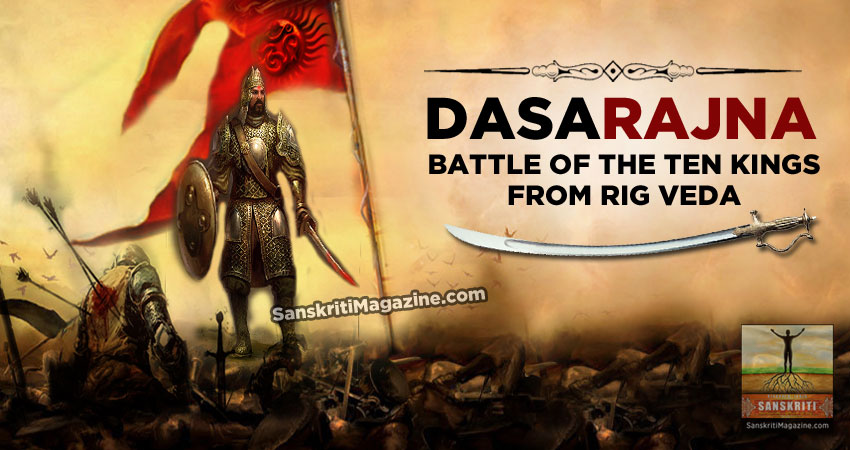When asked about the ancient classics of India, most would quickly reply with The Ramayana and The Mahabharata. Although this answer is correct, there is an even more ancient story that has been forgotten by the bulk of Indians and Hindus globally. That ancient story is called the Dasharajnya or ‘War of 10 Kings’.
Long before Ramayana, there lived a descendent of India’s eponymous king, Bharata, named Sudas. King Sudas was the 16th generation descendant of Emperor Bharata, whom India is named after. Sudas was the grandson of the powerful king Divodas Atithigva (who had his empire in the regions of Punjab and was married to Madhavi) and he was the son of King Pijavana.
In the Rig Veda, King Sudas is called “Paijavana” (VII.18.21-25), ‘Son of Pijavana’. Pijavana also means (like Yavana), ‘one who speeds’ or a fast mover. Yavana is hence here, an adaptation of Javana, and a Vedic term referring to any great monarch, or peoples that migrated fast defeating others. Divodas earned fame as a warrior by waging a long war with the powerful non-Aryan King Sambara whom he ultimately defeated and killed.
According to the 8th book of the Rg Veda, King Divodasa destroyed the 99 towns of the Dasa Chief Sambara and killed Sambara and Varci in the country of Udabraja. The Vedic Rsis used to ascribe these heroic deeds to the Vedic God Indra by saying that Indra rent the 99 cities of Sambara for Divodasa and “saved Divodasa with wonderful means of safety”.
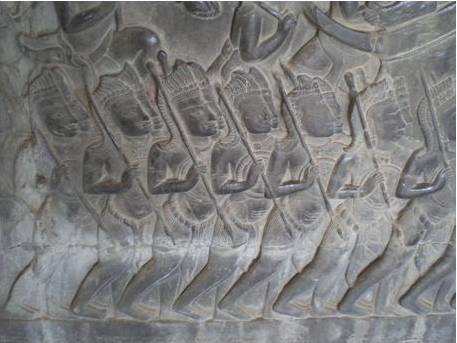 Sudas inherited the kingdom from his grandfather and greatly expanded it. In the process, he alienated all the neighboring kingdoms surrounding him. After years of subjugation, a group of roughly a dozen or “ten” (“dasha”) kings and chieftans (“raja; rajnya”) formed a confederacy to combine their strength and defeat King Sudas once and for all. In a war that would span many years with a number of key battles, Sudas was able to defeat the entire confederacy of kings and emerge victorious. His priests, Vishvamitra and Vasishtha eulogized him for his remarkable victory and those words of praise along with details of the war can be found in the Rg Veda.
Sudas inherited the kingdom from his grandfather and greatly expanded it. In the process, he alienated all the neighboring kingdoms surrounding him. After years of subjugation, a group of roughly a dozen or “ten” (“dasha”) kings and chieftans (“raja; rajnya”) formed a confederacy to combine their strength and defeat King Sudas once and for all. In a war that would span many years with a number of key battles, Sudas was able to defeat the entire confederacy of kings and emerge victorious. His priests, Vishvamitra and Vasishtha eulogized him for his remarkable victory and those words of praise along with details of the war can be found in the Rg Veda.
Some historians from India have taken a negationist stance to ancient Indian history and cling to outdated theories such as the AIT (Aryan Invasion Theory) which highly influences their interpretation of the Rg Veda especially as it relates to the Dasharajnya War.
These historians, whether Marxist or simply Western-biased have taken the 150-year old theory about a supposed ‘invasion’ of India by Aryans around 1500 BCE as a hard fact and a milestone from which to define the remainder of Indian history.
As a result, the ample evidence of royal and priestly chronologies in the Vedas that, when correlated critically with the Puranas, clearly describe a few hundred generations between the founder of India’s recorded civilization, Vivasvata and his son, Manu Vaivasanta and the generation living today, must be completely ignored and converted into fantasy. These historians therefore avoid any views that consider these ancient kings to have been real and instead interpret them to be fictional.
In other words, according to them, India did not have a succession of kings as Egypt did, but rather was an unknown mystery before the Buddha and any mention of kings or priests’ names must be considered as mythology with no underlying historical basis.
Given that position, it is impossible for these ’eminent’ historians to even consider that the royal Indian chronologies when placed in order put Vivasvata at a timeframe long before 3000 BCE and actually closer to 4000 BCE. It is a documented historical occurrence that directly conflicts with the colonial theories of ‘White Aryans’ conquering ‘Black Dravidians’ to create an ‘evil caste system’ which is responsible for the poverty of India and which can only be solved with external (read ‘colonialist’) intervention. As an example, here is the interpretation of the 10 Kings War by historian Romila Thapar:
“If you read the hymns the plea to the gods Indra, Agni, whosoever it is, is help us go and attack this ‘dasa’ village or this ‘dasapura’, help us get the cattle of the ‘dasa’. It is always the cattle that they are wanting. There is no question of help us go into battle and take over a whole territory. It is limited to small areas of attack. They are mobile pastoralists and the cattle raids and the predatory raids are surrogate for warfare. There are in fact no great battles or campaigns. Even the famous battle of ten kings is over the change that is taking place that is being brought into function over the river waters of the Ravi. It is not as if there is huge encampment on a plain and the two armies have got together and are fighting each other. None of that. It is something i.e. very much localized and controlled.”
In fact, many historians claim that this war can only be interpreted as a skirmish over cows and not a kingdom!
It is important to note that the Sanskrit word ‘Arya’ (English: ‘Aryan’) has no racial connotation in the Vedas and is a term originally used to identify the members of the Puru-Bharata Dynasty. Over many centuries, this term gained a broader acceptance as a description of any royal dynasty, then eventually came to be used to describe anyone ‘civilized’ (in opposition to those still leading an unrefined, non-Vedic or even anti-Vedic existence in mountains or jungles who would be referred to as ‘dasa’, ‘dasyu’, ‘mleccha’ and/or ‘rakshasa’).
The interpretation of the significance of the Dasharajnya from the late award-winning historian, P.L. Bhargava however is quite different. Based on his research reading hundreds of texts in original Sanskrit:
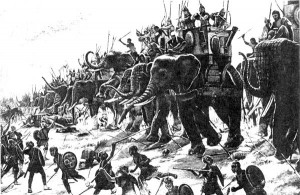 “Sudas is regarded by the Rigveda as a Bharata king of the Trtsu dynasty. The Puranas elucidate the statements of the Rigveda. As Visvamitra himself informs us, under his guidance, Sudas won many victories in the east, west and north of his kingdom. The greatest achievement of Sudas was his thumping victory of a confederacy of ten kings is described in hymn 18 of the seventh book of the Rigveda.
“Sudas is regarded by the Rigveda as a Bharata king of the Trtsu dynasty. The Puranas elucidate the statements of the Rigveda. As Visvamitra himself informs us, under his guidance, Sudas won many victories in the east, west and north of his kingdom. The greatest achievement of Sudas was his thumping victory of a confederacy of ten kings is described in hymn 18 of the seventh book of the Rigveda.
The information is supplemented by three other hymns, viz. nos. 19, 33 and 83. From these hymns it appears that the old hostility between the Bhrgus and the Haihayas played an important part in deciding the affiliations in this battle. The Bhrgus are clearly mentioned in verse 6 of hymn 18, as fighting on the side of the enemies of Sudas. On the other hand, Vitahavya, the great-grandson of the Haihaya king Sahasrabahu, is mentioned in verse 3 of hymn 19, as having been protected by god Indra along with Sudas, which seems to imply that he was an ally of Sudas. Sudas was one of the greatest kings of the Rigvedic age. In recognition of this, he was, like Bharata, consecrated by his priest Vasistha with the Aindra Mahabhiseka, signifying universal sovereignty.”
The Dasharajnya War or “war of 10 kings” was a turning point in the history of India because it firmly re-established the dominance of the Puru-Bharata Dynasty over smaller royal dynasties and tribal chieftains over the Sapta-Sindhu region going west towards present-day Afghanistan/Persia and east towards Uttar Pradesh. This Puru-Bharata Dynasty provided the continuity of leadership which is documented in the ancient scriptures of Sanathana Dharma (Hinduism) particularly the Rigveda. The fact that this great story, which I believe must be raised to the standard of ‘epic’ in all fairness, is relatively unknown and forgotten is surprising and raises questions. When did this war occur? Where did this all happen? Why is it important and why should it be raised to the level of India’s two existing epics, namely the Ramayana and the Mahabharata?
Dating the Dasharajnya War
Given that we have existing archaeological data to approximate the timeframe of the Buddha and before him the Mahabharata War, it would be helpful to determine a realistic timeframe for the Dasharajnya War in order to provide yet another milestone in the long continuum of Indian history. Since the Dasharajnya itself presupposes a lineage of kings before Sudas going back approximately one thousand years to Vivasvata, any milestone we agree upon for this war helps put Indian history in a chronological framework.
In his excellent book, The Myth of the Aryan Invasion, Vamadeva Shastri (David Frawley) dates the Dasharajnya War to 3700 BCE and comments on its historical importance:
“The Vedic war is a question of values, not race. It is a conflict between spiritual values and materialistic values, which occurs in all societies. Sometimes arya people become un-arya by a change in values, as indicated in the battle of Sudas….Even names of famous Vedic kings, such as Sudas and Devadasa have the ending of das or dasa meaning ‘servant’. ” Sudas ruled the land of Sapta Sindhu, centered around the mighty Sarasvati river, which flowed from the Himalayas to the Rann of Kutch. After the Battle of the Ten Kings, many Indians migrated westwards into Iran and beyond.”
In the books by historian P.L. Bhargava however, he arrives at a different date for this war. He takes the 3100 BCE date popularly used as the beginning of this Kali Yuga (Dark Age) as the beginning of the royal dynasties of India starting with Vivasvata. He uses a regnal period of between 16 and 17 years from Vivasvata, who lived 40 generations before Sudas to arrive at approximately 2350 BCE as the timeframe of the Dasharajnya War.
Based on my research however, I have found that a regnal period of 16 or 17 years is too brief. Given that kingship was generally transferred from father to eldest son after the son has completed education and perhaps some real martial experience (i.e., real war), a regnal period would more likely be between 20 and 30 years with an average at 25 years. A study of most ancient civilizations shows this to be a very reasonable estimate. Therefore, I have estimated that the Dasharajnya War most like occurred around 2900 BCE based on aligning Puranic Kings’ lists along with known archaeological evidence.
A dating of 2900 BCE is not as distant as Vamadeva Shastra’s estimate of 3700 BCE nor as recent as P.L. Bhargava’s estimate of 2350 BCE, and actually falls about in between these two dates. In addition, my discussions with historian and author Shrikant Talageri, confirm that this timeframe is reasonably supported by the evidence within the Rigveda and other literature.
Details of the Dasharajna War
The list of confederate kings and chieftans involved in this war is actually slightly over ten, but was referred to roughly as ‘dasha’ (ten) as a shorthand in the Rg Veda:
- Puru: One of the major tribal confederations in the Rigveda.
- Yadu
- Turvasa
- Anu: Some place them in the Parusni (Ravi) area.
- Druhyu: Some align them with the Gandhari (RV I 1.126.7).
- Alina: One of the tribes defeated by Sudas at the Dasarajna and it is suggested that they lived to the NE of Nuristan, because the land was mentioned by the Chinese pilgrim Hiouen Thsang.
- Paktha (‘Pathan’; ‘Pashthun’):
- Bhalinas: Fought against Sudas in the Dasarajna battle and it is argued that they lived in the Bolan Pass area.
- Siva
- Visanin
- Simyu
- Vaikarna
- others
The war comprised AT LEAST two notable battles:
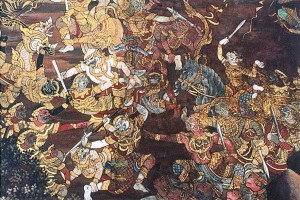 Parushni River Battle – (western border of Bharata kingdom) first main battle of war
Parushni River Battle – (western border of Bharata kingdom) first main battle of war
Yamuna River Battle – (eastern border of Bharata kingdom) after the war was supposedly done, Sudas was attacked on the east by King Bheda (and his Ajas, Sigrus and Yaksus) while Sudas was occupied on the Parusni. Sudas defeated them too. 12,000 warriors were killed from the Druhyus and Anu Kings alone (supposedly a total of 66,666 soldiers fought). This group of 10 may have been led by King Chayamana (of Abhivarta – present Iran). Sudas took over the main area on the Saraswati and North, East and West of it. South of it was controlled by non-Arya kingdoms of Krkata and Pramaganda.
Interesting notes about the Dasharajnya War:
Dasharajnya War mentioned in RV 7,18; 7, 83; and 1-8. This great battle was fought on the Parushni River (Ravi River) with Bharata King Sudas defeating a confederacy of 10+ kings (Anu & Druhyu Kings and over 10 other tribal chieftains and kings).
Rg Vedic hymn (III. 53.14) mentions Kikata and its King Pramaganda. The reference is to Sudas’s battle with the Kikatas and their King Pramagandha (whose name is connected by many scholars with the word Magadha = Pra-Magandha). Indian tradition is very unanimous in identifying Kikata with Magadha (e.g. Bhagvata Purana I.3.24 and Vayu Purana 108.73-74. Nirukta merely says ‘anarya janapada’ and the word does not occur in the other Samhitas). This clinches the origin of the Bharatas in Uttar Pradesh: the expansion of the Bharatas under SudAs took place in two directions, eastwards into Bihar, and westwards across the SarasvatI into the Punjab. Clearly, only a homeland in the area between KASI and KurukSetra fits into this picture.
Emperor Chayamana on the Sarasvati River:
Even on the political and administrative fronts, the Vedic people were highly organised. Not only did they have sabhas and samitis which dealt with legislative and perhaps judiciary matters, but they also had a well-established hierarchy amongst the rulers, viz. samrat, rajan and rajaka. Thus, in RV 6.27.8 Abhyavarti Chayamana is stated to be a Samrat. (Soverign), while RV 8.21.8 states that, dwelling beside the Sarasvati river, Chitra alone is the Rajan (king) while the rest are mere Rajakas (kinglings or petty chieftains). That these gradations were absolutely real is duly confirmed by the Satapatha Brahmana (V.1.1.12-13), which says:
‘By offering the Rajasuya he becomes Raja and by the Vajapeya he becomes Samrat, and the office of the Rajan is lower and that of the Samraj, the higher
(raja vai rajasuyenestva bhavati, samrat vajapeyena l avaram hi rajyam param samrajyam).
AbhyAvartin CAyamAna is an Anu king, and he clearly appears as a hero in VI.27. However, it is equally clear that this is only because he is an ally of the Bharata king SRnjaya: his descendant Kavi CAyamAna who appears (though not in Griffith’s translation) in VII.18.9 as an enemy of the Bharata king SudAs, is referred to in hostile terms. In RV VII.18.8, he was killed while fleeing from battle. He was an enemy of Sudas and son of Cayamana. He was probably brother of Abhyavartin Cayamana who is mentioned as the conqueror of the Vrcicantas under the leadership of Varasikha (RV VII.27.5,8).
Sudas was well known for having two sage advisors, Vasishtha and Visvamitra. He was an author of Hymn 133 of the 10th book of the Rg Veda in addition to being a great warrior and king. He gave much to his priest, Vashistha (200 cows, 2 chariots, 4 horses with gold trappings,…).
Sudas and Bheda: King Sudas also fought with the non-Aryan King Bheda who led 3 tribes (Ajas, Sigrus, Yaksus) against Sudas. King Sudas beat them all at a battle on the Yamuna River.
All enemies of Sudas were defeated, thousands were killed, several drowned and swept away by the mighty rivers and the remaining fled away. Sudas’ armies marched in all directions except the South. He emerged victorious and several gifts were presented to him by the defeated enemy. It was really a great historical event.
Location of the Dasharajnya War
Historian P.L. Bhargava created the following map in his book, ‘India in the Vedic Age’ in order to show the areas described in the Rg Veda:
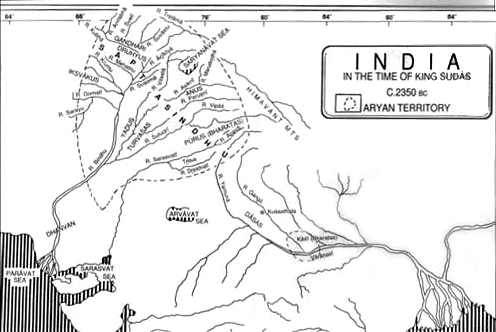
King Sudas, being the heir to the Puru-Bharata Dynasty, had his kingdom centered in the southeastern region of the Sapta-Sindhu with his capital most likely directly upon the Sarasvati River. Even though this river dried up around 1900 BCE (due to tectonic activity), many archaeological ruins of cities along this river-bed exist. It is very possible that one of the larger archeological ruins may be the remains of what was once his capital city. The correlation of ancient scripture and literature with archaeology has been successfully accomplished in the Middle East but much remains to be done as far as ‘Vedic Archaeology’ goes.
Some additional geographical detail can be gathered from the work of historian, U.C. Sharma:
Vedic texts like Shatapatha and Aitareya Brahmanas list a group of ten to sixteen kings, including a number of figures of the Rig Veda like Sudas, as having conquered the region of India from “sea to sea.”
Lands of the Vedic people are mentioned in these texts from Gandhara (Afghanistan) in the west to Videha (Bihar) in the east, and south to Vidarbha (Maharashtra), as well as from the western to the eastern oceans.
Sudas’s capital city was on the Sarasvati River. His queen was named Sudevi. The battle of the ten kings was led against the Turvashas (one of the five vedic people of the RV), the Bhrigus (a family of Vedic seers related to the Angirasas), the Druhyus (one of the five vedic peoples), the Kavashas (a family of Rishis), the Anus (Vedic) (one of the five Vedic peoples) and others (e.g. RV. 7.18.6; 5.13.14; 7.18.12). Rig Veda 7.83.1-6 tells that Sudas defeated both Aryas and Dasyus.
Part of this battle is also fought on the Parusni river, which according to Yaska (nirukta 9.26) refers to the Iravati river (Ravi River) in the Punjab. When Sudas was conquering all around him (with Vishvamitra as his purohit), he conquered to the east, west and north (but not south). Apparently, there was no major kingdom to conquer to the south and/or no land worthy of conquering south (present-day Rajasthan).
The last battle was fought on the banks of the Parushni, where the armies of 10+ kings were defeated. There seems to be an earlier battle against Bheda, the Ajas, the Sigrus, and the Yaksus, where many horses were offered as tribute to the conqueror. Indra made even the vast flowing waters (of the Parusni) shallow and easily fordable to Sudas; he who is fit to be lauded by our hymn, has made the arrogant Simyu and his imprecations the floating dirt (on the surface) of the rivers.
Why the Dasharajnya deserves to become India’s Third Epic
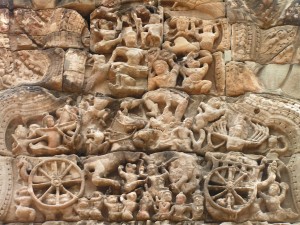 The first of the three major Ithihaasas (historical Epics) of India was the Dasharajnya War (War of 10 Kings). The other two were obviously the Ramayana and the Mahabharata – which occurred later in Indian history. The Dasarajnya War was a Vedic Epic, the Ramayana is mentioned at the end of the Vedas and the Mahabharata Epic is post-Vedic. Unfortunately, the Dasharajnya War was never eulogized and remembered by bards and wandering poets in the manner that the other two epics were and thus most Indians are not aware of this very important historical event.
The first of the three major Ithihaasas (historical Epics) of India was the Dasharajnya War (War of 10 Kings). The other two were obviously the Ramayana and the Mahabharata – which occurred later in Indian history. The Dasarajnya War was a Vedic Epic, the Ramayana is mentioned at the end of the Vedas and the Mahabharata Epic is post-Vedic. Unfortunately, the Dasharajnya War was never eulogized and remembered by bards and wandering poets in the manner that the other two epics were and thus most Indians are not aware of this very important historical event.
It is my strong opinion that the Dasharajnya War should be elevated to its proper status that of the first Ithihaasa of India. When viewed together, the three Ithihaasas show the transition of history in India very clearly. The Dasharajnya shows the consolidation of power in North-Central India with the Puru-Bharata Dynasty, its impact on India and surrounding nations (notably Persia) and its consequent reflection in the consolidation of religious knowledge in the Rg Veda. This in turn would help bring about a new interest in the study of the Vedas not only as scripture, but also as an encyclopedia of ancient, Vedic India. The Ramayana shows the expansion of royal power beyond the Ganga River region into the full breadth of the Indian Peninsula and beyond into the island of Lanka at a time when most areas were still tribal and not yet part of organized kingdoms. The Mahabharata shows a Bharatiya civilization integrated from all four cardinal directions with interdependencies among kingdoms strong enough to result in one inter-kingdom conflict boiling over into the first major civil war of India.
In the manner of the Ramayana and Mahabharata and to have all three of these epics officially recognized as the 3 Ithihaasas of Sanathana Dharma and India, a newly written Dasharajnya Epic can then become part of the vast source material for a newer, more logical view of Indian history and an important component in studying the historical evolution of Sanathana Dharma (Hinduism).
Conclusion
The Dasharajnya War was a key event in India’s history and its protagonist, King Sudas, an exemplary figure. We do a great disservice to India and Dharma by ignoring his legacy. By remembering this event and by raising it up to the status of India’s first epic in a trilogy of epics, we not only pay respect to our ancestor, but we develop a clearer understanding of India’s history and the amazing twists and turns of events that all tie together to create a civilization that would continue many millennia after that epic war.
~ Niraj Mohanka, Historian and Indologist

